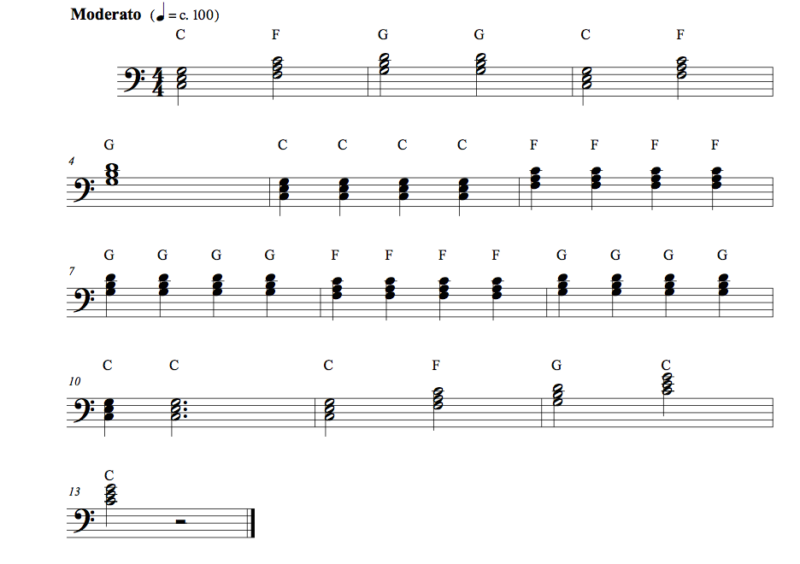Sit in on a jam session or jazz performance. The group seems to know how to play together with little more than a handful of chords jotted down on a lead sheet keeping them together. There is this type of rhythmic harmony, a knowledge of their instruments, being able to read each other’s slightest body movements and signals, that makes the experience enjoyable for listeners and performers. They accomplish this through improvisation.
How can you master the art of improvisation? Like any musical skill, improvisation is not a magical gift. It takes practice and simply the art of doing. The more you improvise, the more confident and accurately you will play. The more confident and accurate, the better you will improvise.
But I’m not going to tell you to just go to your piano and jam. Most folks wouldn’t even know where to start. So instead, I have ten improvisational challenges for you. Believe it or not adding more constraints can actually free you up to build more confident and versatile improvisation skills!
Once you learn how to improvise, you will find that your overall confidence in any performance situation will grow. Improvisational skills give you the ability to create music in seconds, and opens up many more musical opportunities.
How to use Challenges to learn improvisation
Below are ten simple improvisation challenges. Read through the instructions. Try to improvise without hearing the sample. Then after your first try, listen to the improv samples. These audio tracks are not finished engineered mixes that would be impossible to improvise. They are rough improvs, just like the ones you might play. Mistakes were left in, because when you improvise, there will be some mistakes. The key is to keep playing and keep it musical!
 After you listen to the sample improvisation, try the challenge again. For added fun, you might want to invite some friends over and jam through these exercises together. It’s a great way to build up another aspect of improvisation: interpreting the body language of your bandmates in performance.
After you listen to the sample improvisation, try the challenge again. For added fun, you might want to invite some friends over and jam through these exercises together. It’s a great way to build up another aspect of improvisation: interpreting the body language of your bandmates in performance.
These challenges are broken up into three separate musical components: harmony, melody, and rhythm. Each sample focuses on a specific aspect of improvisation.
While most are instrumental challenges, singers can adapt the challenges to their voices, improvising using jazz scat syllables or the neutral syllable la.
Pro tip: Record your improv attempts! It’s daunting at first, but remember it’s for your ears only. Recording and listening back each time you try improvising is the fastest way to improve your skills.
Harmony Challenges
1. All White Keys Challenge
In this challenge you will improvise in the key of C Major, which on the keyboard is all white keys. If you are playing a different instrument like guitar or bass, then just play in the key of C Major. You might find that you instinctively follow common chord progressions like I–IV–V. Try to also explore some less common harmonies as you become more comfortable with improvising in the key of C.

2. Black Keys Challenge in Pentatonic
In this challenge you will play using the pentatonic scale, a five-note scale. On the piano, you would just play the black keys. This five-note scale does not have common harmony: instead it is ambiguous. You find this type of harmony in traditional Appalachian music and in some older transcriptions of music from Asia.

In this second improvisation on the pentatonic scale, I added in a drum loop underneath the improvisation on synth.
3. I–IV–V Chords
In this challenge you will improvise over I–IV–V chords. You can either play through the chords yourself or accompany the audio example below. First play the chords, and then when you are ready, improvise a melody over the chords using the audio clip provided:

4. Dice Challenge
In this exercise you will need dice or you can use an online dice roller. You only need one die. Roll the dice several times. Write down the numbers rolled. Each roll corresponds to a chord in a major scale: 1:I, 2:ii, 3:iii, 4:IV, 5:V, 6:vi.
.
Write down the new chord progression. Don’t worry if it doesn’t follow common tonal harmony practice. This exercise is more about exploring different chord progressions than following tonal harmony. Below is an improvisation sample based on the chord progression below, improvised on string synthesizer using a keyboard. The progression is played through twice, slowly:
Sample roll: 1, 2, 1, 5, 2, 3, 1
Chords: I–ii–I–V–ii–iii–I
For more ideas on dice-based improvisation, check out Tonic. And here’s another game to play your way in that you can adapt for improvisation.
Melody Challenges
1. Random Note Melody
In this challenge, you will choose a scale and improvise a melody in the scale. You can choose a major scale, minor scale, blues scale, or pentatonic scale.
Don’t worry about harmony and chords, or even rhythm. Just explore the notes of the scale. Use both steps and skips, exploring different ways of combining notes to make a melody. For singers, this is an excellent exercise to practice using scat syllables or the syllable la:
Exploring the notes of a scale through improvisations like this is a great way to get familiar with the role each note in the scale plays. For example, listening for the tension created by the leading note (the seventh note in the major scale) or how the subdominant (note 4) and dominant (note 5) lead naturally to each other and to the tonic (note 1).
2. Singing Rhythms
Because singing is an integral part of musicality and good musicianship, learning how to sing is important, even for instrumentalists. In this improvisation challenge, you will take a poem or children’s book and improvise a melody.
- Select an example with simple rhymes. Only use several lines or a first stanza.
- Read over the selection several times out loud.
- Once you are comfortable with the poem, try singing the poem. Don’t worry about what key you are in, or even if the melody is in tune. Just practice improvising.
- Once you are comfortable, try to improvise in a particular scale.
Below is an example from Walt Whitman’s “O Captain! My Captain”. The improvised example is below. Listen for interpretation of the words, dynamics, melodic choice (which was improvised), and the possible underlying chord structure.
O Captain! my Captain! our fearful trip is done,
The ship has weather’d every rack, the prize we sought is won,
The port is near, the bells I hear, the people all exulting,
While follow eyes the steady keel, the vessel grim and daring;
But O heart! heart! heart!
O the bleeding drops of red,
Where on the deck my Captain lies,
Fallen cold and dead.
3. Jazz It Up
In this example, you will select another poem or children’s book. This time, you will improvise using a blues scale. If you find this too complicated, you can simplify the challenge by singing on the note “la” or simply improvising a blues melody on your instrument.
The sample provided above for the Random Note Melody Challenge was actually improvised in the G blues scale:

Rhythm Challenges
1. Percussion Challenge
In this example, you will use the simplest instrument available to you: your body!
Practice clapping, slapping your leg, drumming on your chest, stamping your feet, and creating other percussive sounds on your body.
Once you have explored several different sound choices, then improvise a basic body rhythm. If you need some inspiration, check out the video below of traditional African-American step dancing:
This is a raw unprocessed audio example of body rhythm improvisation using stepping.
2. Waltz with Me
This final challenge combines rhythm, harmony, and melody. Using a simple chord progression, create a short composition in 3/4 time. Use a simple accompaniment repetitive rhythm and easy chord progression using I–IV–V chords. Play a melody over the rhythm on keyboard. Adapt the challenge to your instrument or vocal part.
For example, more advanced students might play a waltz rhythm on the guitar and sing a melody over the chords. If you have difficulty doing this, start by simply tapping out an improvised rhythm in 3/4 time:
You can easily extend this challenge to 6/8 time. Learn how to recognise 6/8 time signatures, and then give it a try!
Jam On!
Now that you have played through these improvisation challenges, create your own using different scales and rhythms. Ask a friend to come over for a jam session, and practice basic improv. Record your improvisations and listen back. Over time you’ll be able to actually hear how your skills are improving.
What are some of the difficulties you faced with each challenge? What were you good at? What needed more work? Keep trying improv challenges, listening back to your attempts and asking questions like these and your improv chops will quickly advance!







